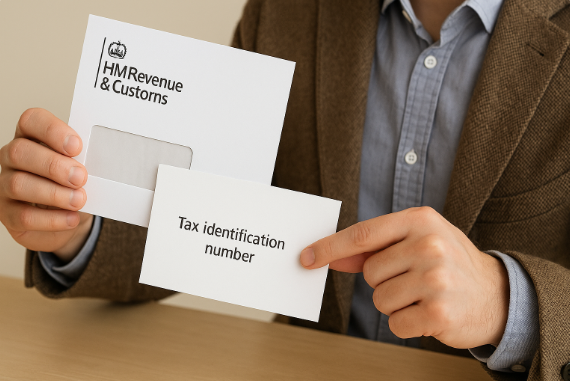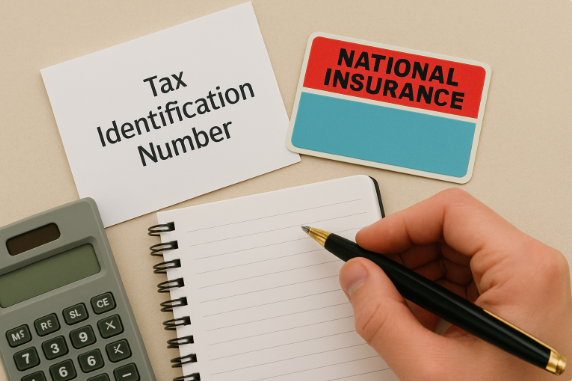Is Tax Identification Number the Same as National Insurance Number? If you’ve ever filled out a tax form or applied for a new job in the UK, you’ve probably come across different identification numbers — some asking for your Tax Identification Number (TIN), others for your National Insurance Number (NIN). It can be confusing because they sound similar, but they serve very different purposes.
Let’s break it down so you’ll know exactly which one you need, when you need it, and how to find it.
What is a Tax Identification Number (TIN) in the UK?
In the UK, a Tax Identification Num ber (TIN) is any number that HMRC uses to identify your tax records. Unlike in the US (where people use a Social Security Number as a tax ID), the UK uses several different references, depending on your situation:
-
Unique Taxpayer Reference (UTR): For individuals who are self-employed or file a Self Assessment tax return.
-
Corporation Tax Reference: For companies registered in the UK.
-
VAT Registration Number: For businesses that are VAT-registered.
-
Employer PAYE Reference: For businesses that employ staff.
So when someone asks for your TIN, they usually mean whichever tax reference applies to your circumstances. For most individuals in the UK, that’s the UTR.
As HMRC explains in their guidance:
“A tax identifier is simply a reference number used to manage your tax affairs.”
UK Tax Identification Number – Where to Find It?

Here’s the question most people ask next: “Okay, so how do I actually find my TIN?” The answer depends on whether you’re employed, self-employed, or running a business.
Where can employees find their TIN in HMRC documents?
If you’re employed and pay tax through PAYE, you may not have a UTR unless you’ve registered for Self Assessment. Instead, your tax identity is usually tied to your PAYE reference number. You can spot it on:
-
Your payslips
-
Your P60 (end-of-year summary)
-
Your P45 (if you leave a job)
It’s usually a combination of numbers and letters, and it tells HMRC how much tax you’ve paid through your employer.
How do self-employed individuals locate their TIN?
For the self-employed, it’s a lot clearer: your Unique Taxpayer Reference (UTR) is your TIN. You’ll see this 10-digit number on:
-
Your HMRC welcome letter (SA250)
-
Any correspondence about your Self Assessment
-
Your HMRC online account (Government Gateway)
If you’ve misplaced it, you can recover it online or by calling HMRC. Don’t ignore it though — without your UTR, you won’t be able to submit your tax return.
Is the TIN the same as the Unique Taxpayer Reference (UTR) in the UK?
For most individuals, yes. In the UK, when financial institutions or overseas tax authorities ask for your TIN, you’ll normally provide your UTR. This is the number HMRC uses to identify your tax records.
Can businesses and companies find their TIN differently than individuals?
Yes. Companies and partnerships may use:
-
Corporation Tax Reference Number (issued by HMRC)
-
VAT Registration Number if VAT-registered
-
Employer PAYE Reference if they employ staff
👉 Quick tip: If you’re unsure, log in to your HMRC online account. All relevant tax numbers (UTR, VAT, Corporation Tax) are listed under your profile.
What is a National Insurance Number (NIN)?
Your National Insurance number is something entirely different. It’s a unique identifier issued by the Department for Work and Pensions (DWP), not HMRC, and it looks like this: AB123456C.
Your NIN tracks:
-
How much National Insurance you’ve paid
-
Your eligibility for the State Pension
-
Access to certain benefits and allowances
You’ll usually find it on your payslips, P60, or official letters from HMRC or DWP. Unlike a TIN, your NIN never changes — it stays with you for life.
Is Tax Identification Number the Same as National Insurance Number in the UK?

This is the big question, and the answer is no.
-
Your TIN (most often your UTR) identifies your tax records with HMRC.
-
Your NIN is used to track contributions, benefits, and pensions.
Sometimes, foreign tax authorities or banks may accept your NIN as your TIN, but within the UK system, they’re not interchangeable.
What are the Key Differences Between TIN and NIN in the UK?
Here’s a quick side-by-side comparison:
| Feature | Tax Identification Number (TIN) | National Insurance Number (NIN) |
|---|---|---|
| Purpose | Identifies your tax records with HMRC | Tracks NI contributions & benefits |
| Who gets it? | Taxpayers (self-employed, businesses, companies) | All UK residents eligible to work |
| Format | Numeric (e.g., 10-digit UTR, VAT No.) | Alphanumeric (e.g., AB123456C) |
| Issued by | HMRC | Department for Work and Pensions (DWP) |
| Where to find | HMRC letters, tax returns, Government Gateway | Payslips, P60, HMRC/DWP letters |
How Do You Find Your Tax Identification Number and National Insurance Number?

If you’re scratching your head trying to remember where you left these numbers, you’re not alone. Here’s how to track them down:
-
-
TIN (UTR, VAT, Corporation Tax, PAYE reference): Check HMRC letters, your Self Assessment forms, or log into your Government Gateway account.
-
NIN: Look at your payslips, your P60, or any official letters about tax or benefits. If you’ve lost it completely, you can request it again from HMRC.
-
What Mistakes Do People Make About TIN and NIN?
-
Some employees give their NIN when asked for their TIN abroad, which may cause delays.
-
Businesses sometimes use their VAT number in place of a Corporation Tax Reference incorrectly.
-
Forgetting your UTR when self-employed can lead to missed filing deadlines.
Tax expert Mike Warburton once said:
“Clarity over tax identifiers matters more than ever, especially with international tax reporting standards.”
Conclusion: Is Tax Identification Number the Same as National Insurance Number in the UK?
To wrap it up: a Tax Identification Number (TIN) is not the same as a National Insurance Number (NIN).
-
Your NIN tracks your National Insurance contributions, state pension, and benefits.
-
Your TIN could be your UTR, Corporation Tax Number, VAT Number, or PAYE reference, depending on how you pay tax.
If in doubt, always check the context. If it’s to do with tax returns, you’ll need your UTR. If it’s about employment or benefits, you’ll need your NIN.
FAQs
Is a National Insurance number the same as a taxpayer reference number?
No. Your NIN is for contributions and benefits, while your taxpayer reference (UTR) is used to manage your tax records.
Do UK citizens have a TIN?
Yes. UK citizens usually use their UTR as their TIN for tax purposes.
Is your UTR number the same as your TIN?
Yes, in most cases. For individuals filing Self Assessment, your UTR acts as your TIN.
What number should I use for tax purposes in the UK?
If you’re employed, HMRC uses your PAYE reference. If you’re self-employed, your UTR is your TIN.

I’m Joe Chris, co-author at ukbusinessmag.co.uk and a long-time enthusiast of all things business and finance. My background is in digital marketing and e-commerce, and I love diving into trends that impact the UK business landscape. Through my writing, I aim to make useful, real-world advice accessible to business owners.



